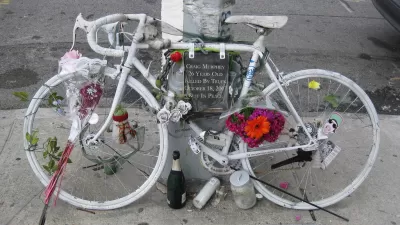Road diets, whereby the number of traffic lanes are reduced to better accommodate cyclists, can be controversial. But what of the opposite—adding lanes to better accommodate motorists? A cyclist died after such an "improvement." A lawsuit followed.

"In June 2012, Dr. Gerald Brett Weiss, a nationally known neurosurgeon, was killed when he was hit from behind while riding his bicycle in the community of Indian Wells [Riverside County], CA," writes Robbie Webber, senior associate at the State Smart Transportation Initiative. "In mid-November of this year his family won a $5.6 million judgment [sic] against Indian Wells, claiming that the city was negligent in not providing sufficient width for bike lanes or lighting that would have prevented the crash."
Never mind that the motorist that killed Dr. Weiss was allegedly drunk, as the city argued. "Experts in court deemed there wasn't enough room in the lane for both the car and the bike, so regardless of alcohol intoxication, the crash was bound to have happened," reports Natalie Brunell for KESQ News. [Video here.]
The roadway had been "expanded from two lanes to three in each direction in 2005, the city did not include a wide outside lane in the design," writes Webber. "In addition, the road previously had bike lanes and was signed as a bike route before the redesign.
Webber's final words are to city transportation planners and engineers:
Governments may want to consider the implications of roadway designs that do not provide safe conditions for all users."
In fact, that's one reason for "complete streets" legislation: to ensure that streets are "designed and operated to enable safe access for all users, including pedestrians, bicyclists, motorists and transit riders of all ages and abilities," according to Smart Growth America.
It's vital to distinguish the "outside," meaning closest to the curb, lane from the inner lanes in terms of lane width. As posted here earlier, it's often preferable to have 10-foot travel lanes over 12-foot inner lanes.
The State Smart Transportation Initiative, housed at the University of Wisconsin, promotes transportation practices that advance environmental sustainability and equitable economic development.
Hat tip to Metro Transportation Library.
FULL STORY: California city loses lawsuit after death of bicyclist on road with substandard bike lanes and no lighting

Pennsylvania Mall Conversion Bill Passes House
If passed, the bill would promote the adaptive reuse of defunct commercial buildings.

Coming Soon to Ohio: The Largest Agrivoltaic Farm in the US
The ambitious 6,000-acre project will combine an 800-watt solar farm with crop and livestock production.

World's Largest Wildlife Overpass In the Works in Los Angeles County
Caltrans will soon close half of the 101 Freeway in order to continue construction of the Wallis Annenberg Wildlife Crossing near Agoura Hills in Los Angeles County.

California Grid Runs on 100% Renewable Energy for Over 9 Hours
The state’s energy grid was entirely powered by clean energy for some portion of the day on 37 out of the last 45 days.

New Forecasting Tool Aims to Reduce Heat-Related Deaths
Two federal agencies launched a new, easy-to-use, color-coded heat warning system that combines meteorological and medical risk factors.

AI Traffic Management Comes to Dallas-Fort Worth
Several Texas cities are using an AI-powered platform called NoTraffic to help manage traffic signals to increase safety and improve traffic flow.
City of Costa Mesa
Licking County
Barrett Planning Group LLC
HUD's Office of Policy Development and Research
Mpact Transit + Community
HUD's Office of Policy Development and Research
Tufts University, Department of Urban and Environmental Policy & Planning
City of Universal City TX
ULI Northwest Arkansas
Urban Design for Planners 1: Software Tools
This six-course series explores essential urban design concepts using open source software and equips planners with the tools they need to participate fully in the urban design process.
Planning for Universal Design
Learn the tools for implementing Universal Design in planning regulations.


























